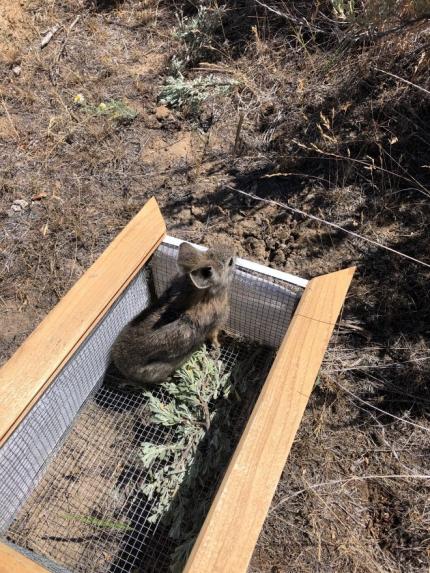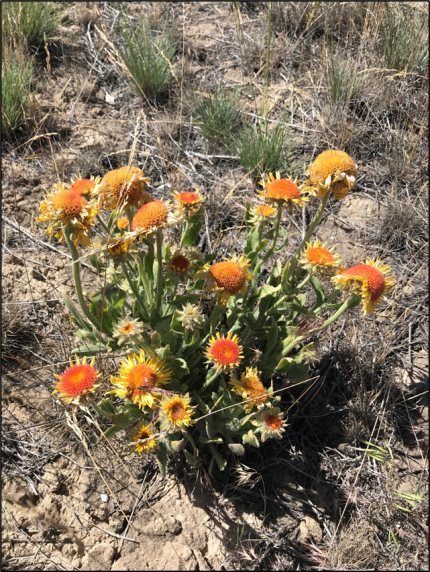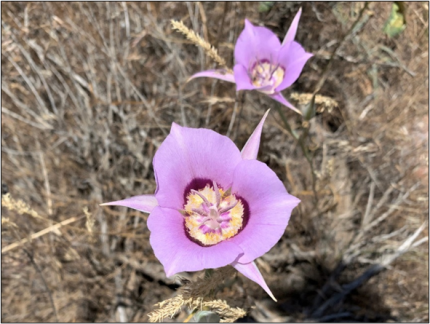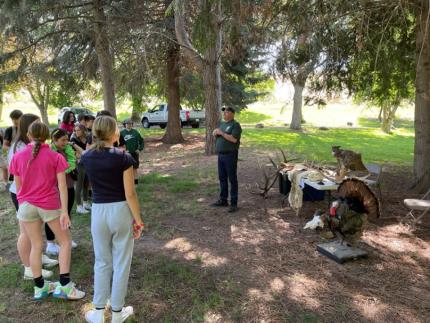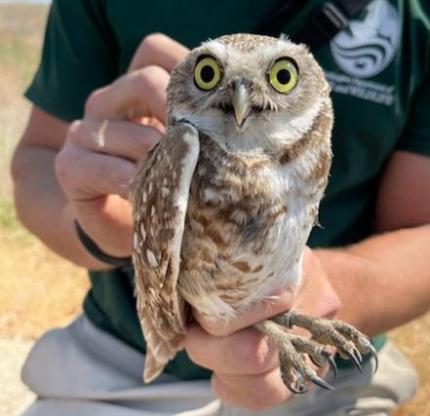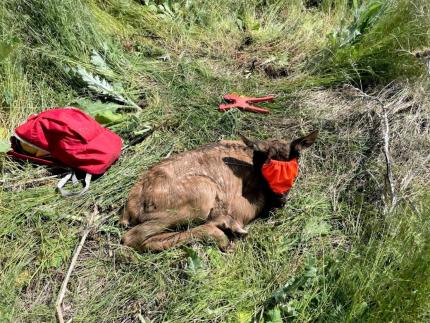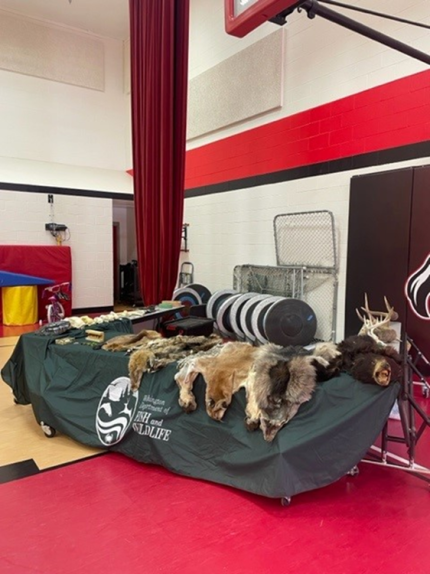Biweekly report Jun1-15 2023 - Region 2 (North Central)
Managing Wildlife Populations
White-tailed Ptarmigan Research: Biologist Heinlen assisted Research Scientist Schroeder with ptarmigan research efforts on Armstrong and Horseshoe mountains in the Pasayten Wilderness. The pair surveyed active male breeding territories and banded eight new birds (four males and four females). Deeper than expected snow conditions precluded camera checks and the retrieval of a transmitter (suspected mortality), so those tasks will wait until later in the summer.
Bat Colony Surveys: Biologist Fitkin assisted Biologist Tobin and the Region 2 Diversity field staff members with bat colony survey work at three sites in the Methow Valley. The team documented over 300 individuals at a large pallid bat colony, 108 individuals at a big brown bat colony, and a handful of individuals (Myotis spp.) at the third site which will be revisited later in the summer in the hope of detecting more activity. This is part of a broader long-term inventory and monitoring effort for bats in Washington.
Fisher Reintroduction Monitoring: Biologists Fitkin and Heinlen with help from Volunteer Fisher (ironic, we know) began retrieving the remote camera sites deployed last fall. This work is part of the North Cascades fisher occupancy monitoring effort following their recent reintroduction. A camera deployed along the Methow River near Mazama detected a fisher this spring. This animal was found in an area where a credible report from a Washington Department of Fish and Wildlife fish biologist had occurred several months earlier. This sighting suggests the fisher is a possible resident animal. As always, the cameras are documenting a variety of other species of interest as well.
Bobcat-Lynx Research: Earlier in the winter, Biologists Fitkin and Heinlen had assisted with remote camera deployment for a bobcat-lynx seasonal habitat use study in District 6. This study was overseen by Furbearer Specialist Welfelt. Recently Graduate Student Singh retrieved the cameras and discovered that one of the units deployed by Biologist Fitkin had captured a great sequence of a lynx chasing a snowshoe hare. Support for the old adage “it’s better to be lucky than good”?
Providing Recreation Opportunities
Hunter Access: Biologist Morris continued checking and posting signs on hunter access properties. Morris maintains signs on several thousand acres, so working on them throughout the summer ensures all properties will be properly posted for hunting season this fall.
Fishing Access: June 1 was opening day for Grimes Lake. Grimes Lake is unique because the main access site is via private property. Biologist Morris ensured the gate was open and spoke to some anglers that had already had success catching trout that morning. Wenatchee Valley Fly Fishers typically pay for a porta potty to be placed at the access site, but this year the normal servicer declined to provide a porta potty. Morris helped arrange for a new servicer to provide the toilet. Besides fish, Morris saw lots of fun wildlife.
Conserving Natural Landscapes
Weed Control: Scotch Creek Wildlife Area staff members started their yearly musk thistle control efforts on the Chesaw Unit. Staff members focused on the southern, warmer slopes because that is where the Class B thistle shows up first. Approximately 500 acres of the unit has been covered. It will take about four weeks to cover the remainder of the unit. Additionally, Scotch Creek Wildlife Area staff members also hand pulled hoary alyssum on the Charles and Mary Eder Unit.
Methow Wildlife Area staff members have also been busy with noxious weed control. All known patches of Scotch thistle have been treated with herbicide or mechanically removed. Scotch thistle is a Class B noxious weed in Washington requiring all propagation to be stopped. Additionally, Biologist Repp released a total of 2,400 Aulacidea acroptilonica, a Russian knapweed bio control agent, at six different sites across the wildlife area. Aulacidea acroptilonica is a host-specific, gall-forming wasp. Gall induction diverts nutrients from flower formation, seed production, and normal growth of plant tissues. Stress induced in the plant can reduce long distant spread of the weed.
Dalmatian Toadflax Biological Control Release: Private Lands Biologist Braaten purchased and delivered 33 releases (4,500) of dalmatian toadflax stem boring weevils (Mecinus janthinformis) to Washington Department of Fish and Wildlife (WDFW) cooperators.
Private Lands Biologist Braaten’s extensive evaluation and his determination of the appropriate locations for release of dalmatian toadflax in Douglas County resulted in specific deployment. Private Lands Biologist Braaten delivered biological control insects to a WDFW cooperating landowner Richard Rice to release on his farm in Douglas County. Biological agents were released in Conservation Reserve Program fields to control dalmatian toadflax.
Many areas in Douglas County that held previous populations of stem boring weevils were destroyed by Pearl Hill Wildfire in 2020. Braaten is working to reestablish weevil populations to be effective against these aggressive noxious weeds. Nice work!
Fencing: Methow Wildlife Area staff members met with Capital Asset Management Program (CAMP) and the fence contractor who won the bid to rebuild a boundary fence burned in the Cub Creek 2 Fire. Work is slated to start later in the month. This fence is a critical piece in minimizing unauthorized grazing from cattle entering WDFW lands from neighboring private and federal lands.
Forest Health: Commercial thinning operations are wrapping up in the Cub Creek area and the contractor is moving equipment to start operations in the Methow Unit. This is the final unit to be commercially thinned for this project. One to three years post thinning, Methow Wildlife Area staff members plan to reintroduce low intensity ground fire back into these treatment units in the form of prescribed fire operations.
Virtual Fencing: Assistant Regional Wildlife Manager Troyer has been working with various partners to begin the process of transitioning some grazing allotment on the Methow Wildlife Area to virtual fencing. Recently, Troyer was able to officially purchase the first two base stations to make this project a reality. Over the next several years, Troyer hopes to transition upwards of half of all grazed acres on the Methow to virtual fencing. It’s possible this practice will expand throughout the Department managed lands in Okanogan County if more operators are willing to transition to this new and inventive technology.
Habitat Plots: Biologist Morris checked his game camera on a habitat plot. The game camera serves two purposes. It will hopefully reveal any wildlife use of the habitat plot, and it will also show the plant development and growth throughout the year. There were not many wildlife observations, but the camera did capture one of the very leafy golden currant bushes blown over by the wind. It appears the plant is surviving, despite the main stem being broken by the wind. Additionally, the plants appear to be healthy and growing well, which is good going into what could be a very dry summer.
Biologist Cook and Technician Blanchard planted several food plots in Grant and Adams counties. The plots were delayed due to irrigation being installed and another plot had weed problems that required more control before planting. Species planted will be irrigated and provide cover during the season and over the winter. The food plots will be a food source mainly in winter for upland birds, but they will also benefit insects and songbirds.
Conducting Business Operations and Policy
Methow Wildlife Area Planning: Staff members held a Wildlife Area Advisory Committee meeting and field trip to Pipestone Canyon. They discussed recreation and trail use. A recreation sub-committee is being formed.
Wildlife area planners held two days of meetings working on the new Methow Wildlife Area management plan. Recreation and travel management were the major topics of the meeting.



















































